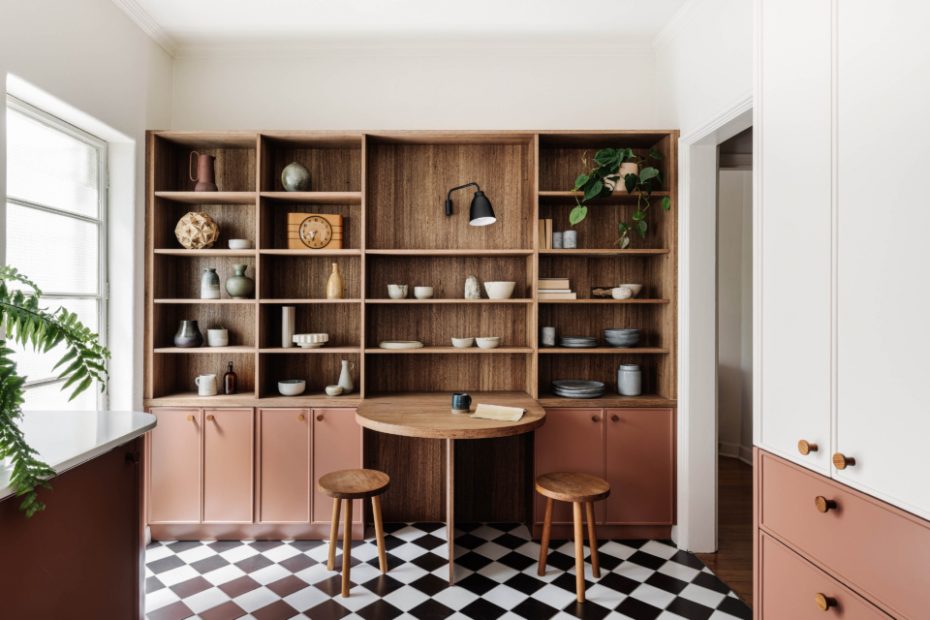How A One-Bedroom Art Deco Pad Cleverly Saves On Space
Interiors
Extra space behind the rear door allowed for full wall shelving using Australian blackbutt timber. Dining stools from Pop + Scott. Fritz Hansen ‘Caravaggio Read’ wall light also featured.
Rich tobacco stained joinery adds to the Art Deco feel. Floral painting on wooden shelf by Betty Heinz. Hanging Kitchen Rod from Ferm Living in ‘brass’.
Splashback tiles by Nagoya Mosaic-Tile Co.
Cabinetry painted in Dulux ‘How Now‘ and ‘Grand Piano‘. Tapware from Faucet Strommen.
Beautiful curves to keep with the Art Deco style.
Integrated appliances help to maximise space.
Plenty of natural light from a window previously covered by a fridge!
Hallway niche with artwork by Deanna Gilson.
Sage bathroom tiles reflect the original tiling.
Bathroom cabinetry in Dulux ‘Deep Aqua‘. Ledge made from Australian hardwood blackbutt timber.
The building was constructed in 1938 and features gorgeous Art Deco architecture including curved balconies and windows.
A double-door entryway to the kitchen was knocked out in place of an archway. The curved dining table is designed to drop down when not in use.
If you’re familiar with the South Yarra area, you’ll likely know Park Towers — a classic Art Deco block of 18 apartments just off Toorak and St Kilda Roads, designed in the 1930s by renowned architect Arthur Plaisted.
When Brave New Eco founder and interior designer Megan Norgate was enlisted to upgrade one of the top floor apartments last year, it was in fantastic condition given its age. The original hardwood floors were still intact, as was the archetypal Art Deco fireplace, while a spacious curved balcony and large windows offered stunning views across the leafy outlook.
But a later renovation in the 1960s meant the kitchen and bathrooms were falling apart and had awkward layouts. The cooktop had been moved away from its original location and didn’t have a range hood, so the apartment was constantly filled with greasy cooking steam! The fridge was also blocking a gorgeous window in the kitchen that when removed, allowed plenty of natural light into the space.
As for the bathroom, the toilet was inconveniently crammed beside the vanity, and a planned hob (small step) into the shower took up extra space in the already tiny room.
Luckily, when the team got to work demolishing the bathroom, they found two layers of floor tiles! Replacing them with just one layer, there was a bit more height to work with, allowing for a complete reconfiguration of the space.
‘A narrow bath was removed and replaced with a large shower, transforming the previously small space into one that feels open and generous,’ Megan explains. ‘The original stucco walls in the bathroom were also redone by a plaster artisan, and have become one of our favourite textural elements of the project.’
Both the bathroom and kitchen interiors largely took inspiration from the hues of the building’s historic architecture — jade tiling in the bathroom references its original tiles, while curved timber joinery in the kitchen is stained in a rich tobacco shade, adding to the contemporary Art Deco feel and complementing the handmade brass accents throughout.
To achieve the end result without any structural changes to the internal walls, Megan and her team needed to maximise as much of the small space as possible. So, they added features such as integrated kitchen appliances to help reduce the visual clutter.
A shallow space behind the back door also provided the perfect spot for a full wall of shelving to create more storage, while a curved drop-down kitchen table allowed for an eating area that’s easily stowed away when not in use.
The end result is a bright and stylish apartment that accommodates modern living and cleverly saves on space, but still embraces the character of the building and its signature Art Deco elements.
